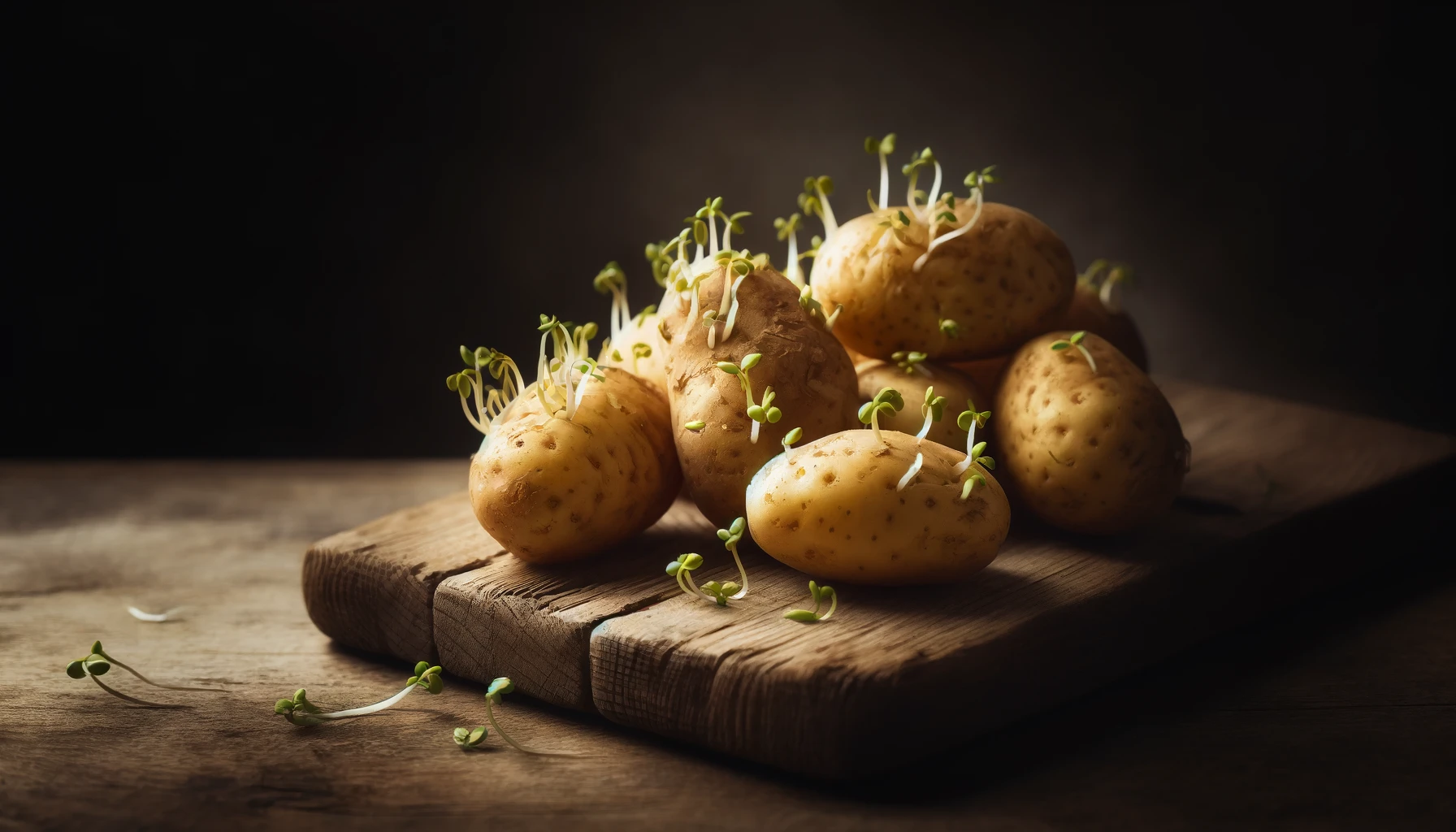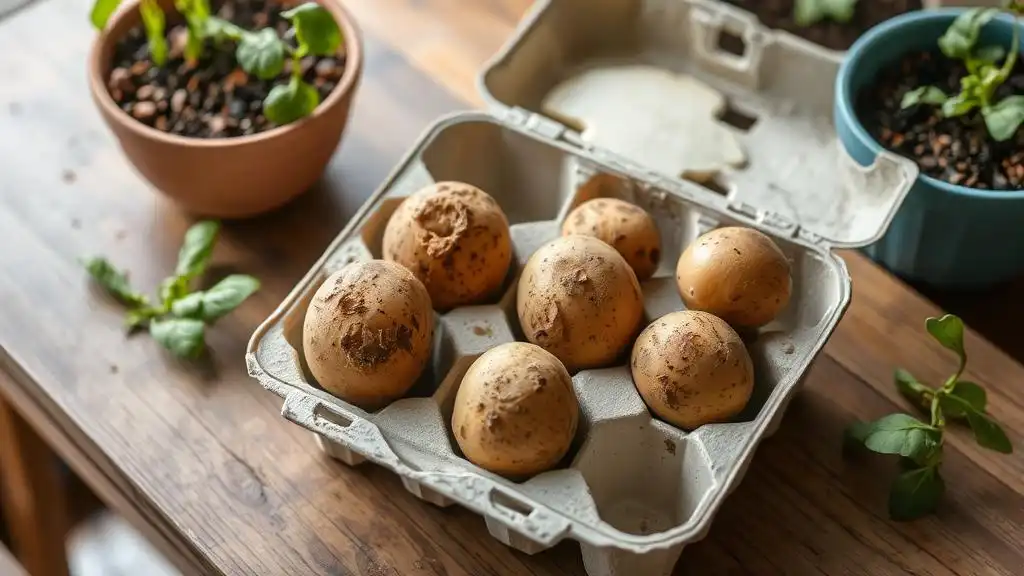Born in Containers: How to Plant Sprouted Potatoes

A sustainable lifestyle is one of the perspectives that involves using products wisely, especially when it comes to culinary activities and possible food waste. Sprouted potatoes are frequent guests to any pantry, but disposal of these vegetables is a real sin. The most harmless way to make use of sprouted potatoes is to plant them at home. But how?
Contents:
A sustainable lifestyle is one of the perspectives that involves using products wisely, especially when it comes to culinary activities and possible food waste. Sprouted potatoes are frequent guests to any pantry, but disposal of these vegetables is a real sin. The most harmless way to make use of sprouted potatoes is to plant them at home. But how?
“How do you plant potatoes that have sprouted?”, one may ask. To answer this question, we have compiled the most relevant information about planting sprouted potatoes and a useful tool that can make this experience smoother.

Why Do Potatoes Sprout?
Have you ever pondered the reason behind those recently purchased potatoes sprouting after some time? Sprouting is basically a natural biological process the aim of which unsurprisingly consists in propagation and further reproduction. When potatoes sprout, it means that it is sufficiently warm, moist, and well-lit around them so as to evoke dormant buds, i.e., the eyes of the potato, and force them to grow.
What can contribute to this process?
Storage Conditions.
Those potatoes that were initially put in warm and humid conditions will sooner or later sprout. This is why most cooks hold them in cooler, dark storage to keep them fresh for longer periods of time.
The Quality of a Potato.
Like any other living beings, potatoes undergo cyclical phases of development the end of which presupposes reproduction. Freshly harvested potatoes do not usually sprout, for they are young and have to go through the cycle before they are ready to sprout.
Light Exposure.
One of the key aspects that affects the time it takes for a potato to sprout is the light. Prolonged light exposure is to inevitably trigger the process of sprouting, while darker environments extend the period of tubers’ dormancy.
Sprouting is a survival mechanism that cannot be prevented but delayed. Some gardeners who want to support the natural processes and rely on what Mother Nature gives only may accelerate the sprouting by creating an appropriate environment themselves.

A Way Out: How Do You Plant Sprouted Potatoes?
Planting sprouted potatoes is a relatively easy procedure, when one is equipped with sufficient knowledge of how to prepare tubers and when to plant sprouted potatoes as well. For you not to act intuitively but stick to the proper planting routine and get a rich harvest in the end, we have developed a step-by-step guide presented below.
Step 1. Check the Timing.
As a rule, the most appropriate time to plant potatoes starts in early spring. Nevertheless, it totally depends on the region-specific factors, so you better consult local plant nurseries, farmers, or other plant enthusiasts. The requirement that should always be met is waiting for the soil to maintain temperatures above 40°F (5°C) to facilitate proper growth.
Step 2. Select Healthy Sprouted Potatoes Only.
Potatoes put in a warm and humid environment may not always be as good as expected. Certain tubers may succumb to deterioration, fungal infestations, or other adverse conditions, which makes them unsuitable for further growth and development.
Step 3. Prepare the Potatoes.
As usual, potatoes should have several sprouts all over the surface, this is why it is important to carefully cut them into pieces with at least one bud and a sufficient amount of flesh attached. Next, one should leave potatoes for 2 or 3 days so as to give the potato skin some time to dry and form a callus, too.
Step 4. Proceed with Soil Preparation.
Potatoes usually prefer slightly acidic (5.0 to 6.0 pH), well-drained, rich soil in organic matter, so consider working compost or manure into the soil to improve its fertility. Since potatoes grow under the surface of the soil, you should give them enough room to develop successfully. Therefore, mound the soil into rows of 8" and 12" tall.
Step 5. Plant the Potato Sprouts.
Finally, we have come to the most productive and noticeable part of this process, i.e., planting our potato sprouts. So, how do you plant a potato that has sprouted? Dig holes about 4 inches deep, place the potato pieces with the sprouts facing upwards, and cover with soil.

Step 6. Water Your Newly Arranged Rows.
Afterward, it is essential not to forget about thorough watering. Mind that the soil should constantly remain moist but not waterlogged for sprouts to grow and form new tubers.
Step 7. Take Care of the Plants as They Grow.
Although the process of planting sprouted potatoes is finished, it is still important to help your plants grow and address any newly emerging issues on the spot. Continue to regularly water potatoes, check the plants for pests and diseases, mulch, and add fertilizers, if necessary.
Some Notes About Garden Assistants
Some novices and amateur gardeners may believe that planting is the most important and difficult part of the whole gardening process. In reality, it is not true. To ensure a garden will produce a rich harvest by the end of the season, one should take care of the yard properly and keep track of any changes every day. So overwhelming could it be!
There exist various platforms for plant lovers of all proficiency levels, and the most universal yet effective tool to promote the health of your plants is AI Plant Finder. AI Plant Finder is a handy assistant that lives in your phone but does not need anything but your curiosity and great interest.

AI Plant Finder is a great app, for it offers different features that cover as many demands as possible thanks to the constantly evolving system and the team of dedicated nature lovers. Among the most prominent services are plant & disease identification by photo, plant care reminders, a personal plant diary aka “My Garden”, an AI botanist, a water calculator, a light meter, and more. And 400,000 plant species located in the app’s storage may get closer to you, but not physically for sure.
Do not postpone your planting routine. Grab your phone and follow thoroughly prepared guides to ensure you have a thriving garden. Explore the diversity of AI Plant Finder and keep up with trends in present agriculture.
Share:
Read More
Identify Any Plant, Diagnose Every Disease
Download Our App Now!


